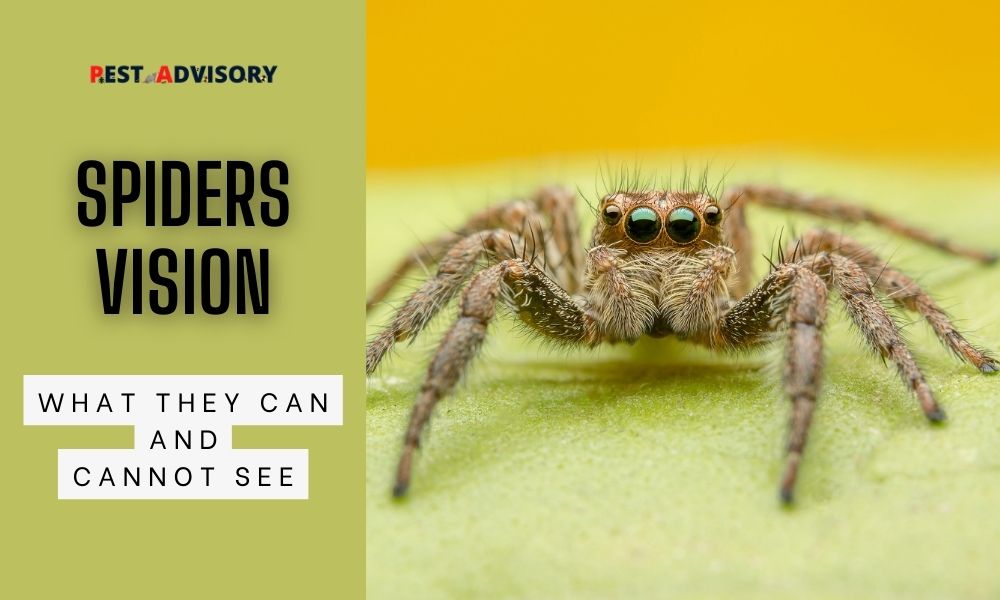Step into the captivating realm of spider vision, where eight-legged creatures navigate their intricate webs with precision and skill.
Beyond their formidable fangs and delicate legs lies a visual world that holds mysteries yet to be unraveled.
In this article, we delve into the fascinating world of spider vision, uncovering the nuances of their eyes and the astonishing abilities they possess.
Important Note: If you're tired of pests and want a reliable solution, then you should definitely consider seeking help from a professional pest control company. DIY solutions can be effective, but if you're dealing with a significant pest infestation, you don't want to rely solely on DIY methods. Pest control companies typically don't charge huge fees. You can fill out this form to receive free quotes from the top local pest control companies, and compare the quotes and see for yourself. Then, finally, your pest problems will be eliminated for good.
Prepare to be amazed as we shed light on what spiders can and can’t see, revealing a hidden realm of sensory wonders.
What Type of Eyesight Do Spiders Have?
Spiders possess a remarkable diversity of eye types and structures, each suited to their specific hunting strategies and habitats. These eyes can be categorized into two main types: simple eyes (ocelli) and compound eyes.
Simple Eyes
Simple eyes, also known as ocelli, are typically small and located on the top of a spider’s head.
They are simple, single-lens eyes that are primarily sensitive to changes in light intensity rather than detailed images.
Ocelli help spiders detect movement and respond to sudden changes in their surroundings.
Compound Eyes
Compound eyes, found in some spider species, consist of multiple individual lenses called ommatidia.
Each ommatidium captures a small portion of the visual field, and the combined inputs from multiple ommatidia create a mosaic-like image.
Compound eyes provide spiders with a broad field of view, allowing them to monitor their environment for potential threats or prey.
Arrangement and Distribution Of Eyes
The arrangement and distribution of eyes on a spider’s body can vary significantly between species. Some spiders have eyes positioned in a cluster, while others have eyes spread out across their cephalothorax.
The number of eyes can also differ, ranging from two to eight. This diversity in eye placement and numbers reflects the adaptations spiders have undergone to best suit their specific hunting strategies, lifestyles, and environmental conditions.
Specialized Eye Structure
Additionally, spiders possess specialized eye structures such as lenses, corneas, and retinas.
These structures work together to focus light onto the sensory cells and facilitate image formation.
The varying shapes and sizes of these eye components contribute to differences in visual acuity and resolution among different spider species.
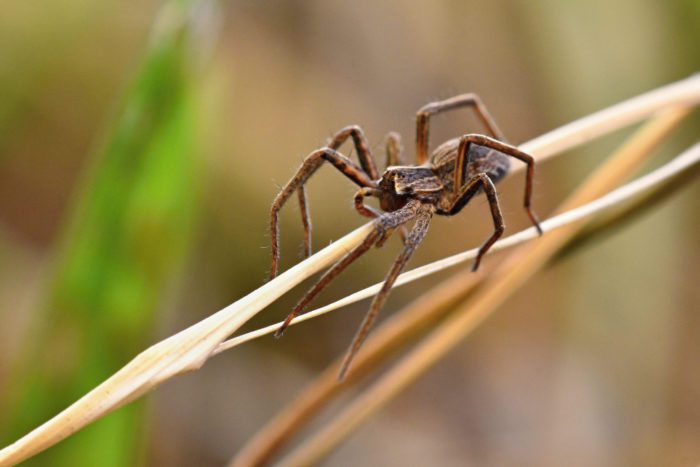
What Can Spiders See?
Spiders have a range of visual capabilities that allow them to perceive and interact with their environment. Here are some aspects of what spiders can see
Motion Detection
Spiders are highly sensitive to movement and can quickly detect even subtle changes in their surroundings. This ability is crucial for hunting prey, as it helps them spot potential meals and respond accordingly.
Light and Dark Contrasts
Spiders can distinguish between light and dark areas, enabling them to navigate their surroundings and locate objects of interest. This ability is particularly useful for finding shelter, building webs, and identifying potential prey or predators.
Color Vision
While the color vision of spiders is not as developed as that of humans or some other animals, many spider species can perceive a limited range of colors.
They are typically more sensitive to shades of blue and green and may have difficulty differentiating between certain colors like red and yellow.
Depth Perception
Some spiders, particularly those with large forward-facing eyes, possess stereoscopic vision, which allows for depth perception. This helps them judge distances accurately and make precise movements when hunting or navigating complex terrain.
Web Detection
Spiders can see their own webs and use visual cues to assess the condition and readiness of their intricate silk structures. They can quickly detect disturbances or prey caught on the web, allowing them to respond accordingly.
Silhouette Recognition
Spiders have the ability to recognize the silhouettes or shapes of objects. This allows them to differentiate between potential prey, predators, or other spiders, aiding in their survival and reproduction.
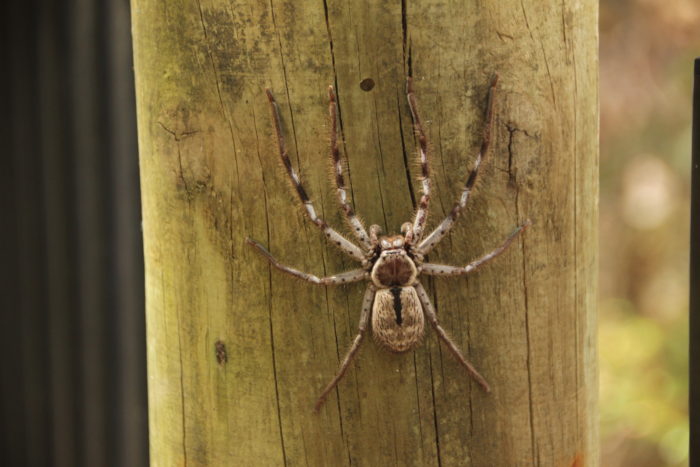
What Can Spiders Not See?
While spiders have impressive visual capabilities, there are certain limitations to their vision. Here are some aspects that spiders generally cannot see
High-Resolution Details
Unlike humans, spiders do not possess the same level of visual acuity when it comes to perceiving fine details. Their vision is more adapted for detecting movement and larger objects rather than intricate features.
Clear Images at a Distance
Spiders may have difficulty perceiving clear images or distinguishing fine details when objects are far away. Their visual acuity is typically optimized for close-range vision, as they rely on visual cues for hunting and capturing prey in their immediate surroundings.
Extended Color Spectrum
While spiders can perceive certain colors, their color vision is not as extensive as that of humans. They may have limited sensitivity to colors such as red or yellow, and their color perception is often biased toward shades of blue and green.
Complete Focus
Spiders have a fixed lens focus, meaning they cannot adjust their eyes to focus on different distances like humans can. This limits their ability to clearly focus on objects at various distances simultaneously.
Clear Vision in Low-Light Conditions
Although some spiders have adaptations for seeing in dim light, their vision is generally not as effective in complete darkness or extremely low-light conditions.
They rely on other senses, such as touch and vibrations, to complement their vision in such situations.
Transparent Objects
Spiders may have difficulty perceiving transparent or translucent objects, as their visual system relies on detecting light reflections and contrasts.
This limitation can make it challenging for them to spot certain predators or prey that blend in with their surroundings.
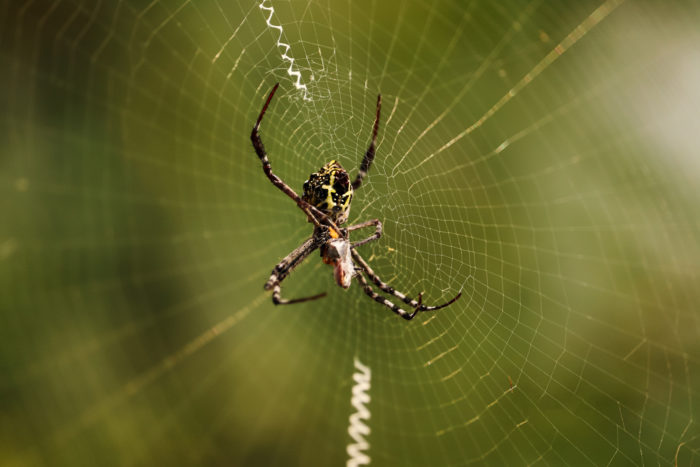
How Spiders Utilize Their Eyes For Web Building and Hunting
Spider vision plays a crucial role in the remarkable abilities of web-building spiders to construct intricate webs and capture prey effectively. Here’s an overview of how spider vision is utilized in web building and hunting:
Web Building
Spiders meticulously construct their webs, and vision aids them in this process. They use visual cues to assess the environment, identifying suitable locations to build their webs.
They look for areas with ample prey traffic or where their webs are less likely to be disturbed.
Visual perception helps them select optimal anchor points and plan the positioning of threads and spirals.
Web Orientation
Spiders utilize visual feedback to ensure proper web orientation.
They assess the angles of the web strands and make adjustments as needed to maintain the optimal shape and stability of the web.
This allows them to capture prey effectively by maximizing the chances of prey encountering the sticky strands.
Prey Detection
Once the web is in place, spiders rely on their vision to detect prey that becomes ensnared in their webs.
They are sensitive to vibrations and movements on the web’s surface, responding quickly to capture trapped insects.
Visual cues alert them to the presence and location of struggling prey, enabling a rapid response.
Strike Accuracy
When hunting, spiders rely on their keen vision to accurately strike and subdue their prey.
They calculate the distance and direction of their prey, adjusting their movements accordingly.
Some spiders, such as jumping spiders, exhibit impressive agility and precision during hunting, thanks to their well-developed depth perception and acute vision.
Camouflage and Mimicry
Certain spiders employ visual camouflage or mimicry to deceive their prey or avoid detection by predators.
They may have color patterns or body shapes that blend with their surroundings, making them less visible to both prey and predators.
Visual perception helps these spiders assess their environment and adjust their appearance to match their surroundings effectively.
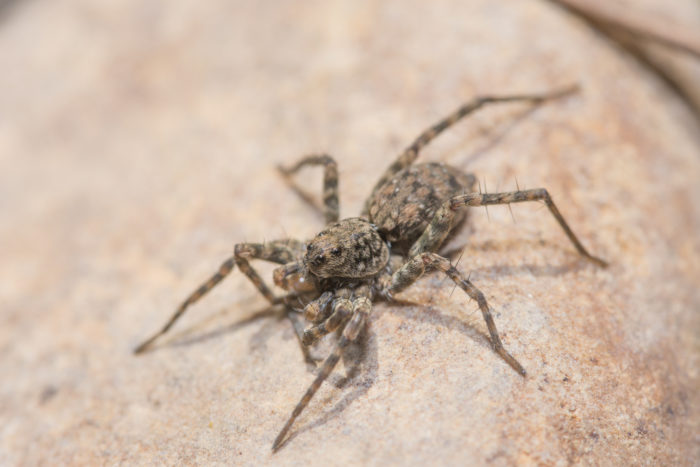
Frequently Asked Questions
Do all spiders have good eyesight?
No, not all spiders have good eyesight. Most spiders have eight eyes, but few have good eyesight.
They are able to detect little more than light-dark intensity changes which stimulate nocturnal web building, hunting or wandering activities, and rapid movement to allow quick reactions against daytime predators.
However, some spiders such as wolf spiders, flower spiders, jumping spiders, and net-casting spiders have excellent eyesight.
Can spiders see in color?
Yes, some spiders can see in color.
Many spiders have a form of color vision based on green and ultraviolet hues, which extends their vision beyond what humans can see into the deep violet end of the spectrum, covering the blue and purple hues in between.
Some spiders, such as jumping spiders, even have a trichromatic vision and can see more colors than humans can.
However, others like wolf spiders have dichromatic vision, which means they are basically colorblind.
Why do spiders have 8 eyes if they can’t see?
Spiders have 8 eyes, but not all of them can see well. Spiders rely on their eyesight to varying degrees depending on their lifestyle and hunting methods.
For example, jumping spiders have excellent eyesight and use it to hunt prey, while web-building spiders largely rely on vibrations in their webs to detect prey.
Additionally, some spiders use their eyes for other purposes, such as detecting predators.
In short, having multiple eyes helps spiders to be more aware of their surroundings and quickly detect any potential threats or opportunities for food.
Do spiders use their eyes to hunt?
Yes, many spiders use their eyes to hunt. Spiders that are active hunters, such as jumping spiders and wolf spiders, have well-developed eyesight and use it to locate and track prey.
The vision of hunting spiders helps them to identify potential prey, judge distances, and make accurate leaps or pounces.
However, web-building spiders rely less on their eyes and more on other senses such as vibrations in their webs to detect prey.
Overall, eyesight is an important tool for many spiders that actively hunt and catch their food.
Can spiders see in the dark?
Spiders, despite being mostly nocturnal creatures that are usually equipped with 8 eyes, do not generally see very well in the dark.
Most spiders cannot see in complete darkness and have poor vision, and some are even blind.
However, some spider species have adapted to low-light conditions, and their eyes have specialized adaptations to provide outstanding low-light night vision, allowing them to hunt and navigate in dim light.
One example of such spiders is the “ogre-faced spiders” found in Australia, which have large, curved lenses specialized for night vision.

Conclusion
As we unravel the mysteries of spider vision, a captivating world of sensory wonders unfolds.
From the intricate structures of their eyes to their remarkable abilities in web-building and hunting, spiders possess a unique visual perception that shapes their interactions with the environment.
While their vision may have limitations, their adaptation to specific niches showcases the diversity and ingenuity of nature.
Understanding spider vision provides us with insights into their fascinating lives, inspiring a deeper appreciation for these remarkable arachnids.

